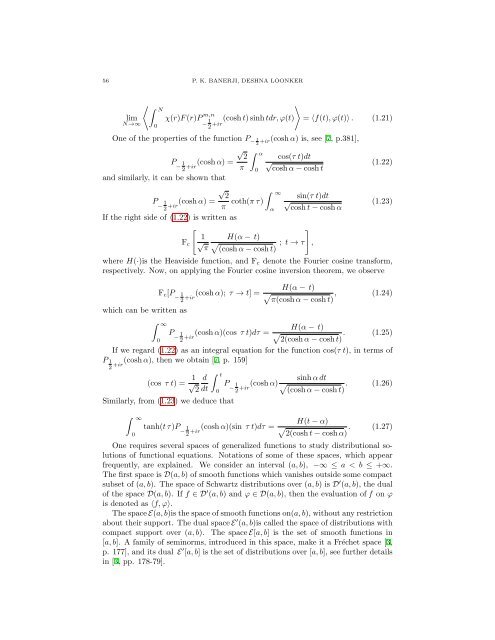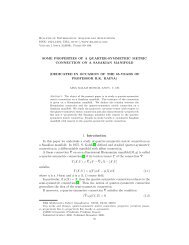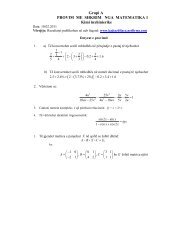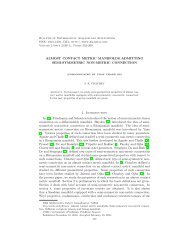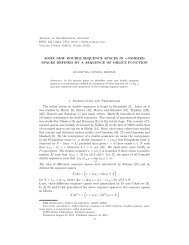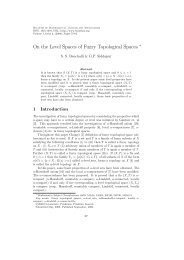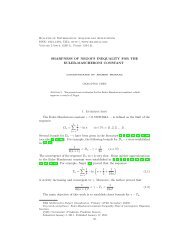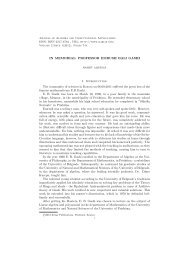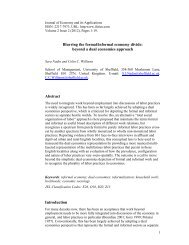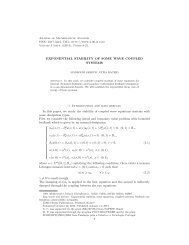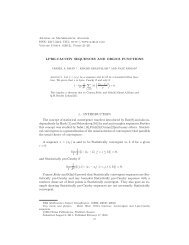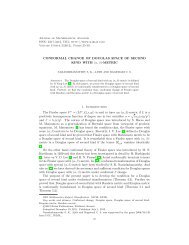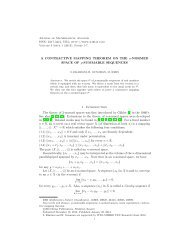DUAL INTEGRAL EQUATIONS INVOLVING LEGENDRE ...
DUAL INTEGRAL EQUATIONS INVOLVING LEGENDRE ...
DUAL INTEGRAL EQUATIONS INVOLVING LEGENDRE ...
Create successful ePaper yourself
Turn your PDF publications into a flip-book with our unique Google optimized e-Paper software.
56 P. K. BANERJI, DESHNA LOONKER<br />
lim<br />
N→∞<br />
〈 ∫ N<br />
0<br />
χ(r)F (r)P m,n<br />
− 1 2 +ir(cosh t) sinh tdr, ϕ(t) 〉<br />
= 〈f(t), ϕ(t)〉 . (1.21)<br />
One of the properties of the function P − 1<br />
2 +ir (cosh α) is, see [7, p.381],<br />
√<br />
2<br />
P 1 −<br />
2 +ir(cosh α) = π<br />
and similarly, it can be shown that<br />
∫ α<br />
0<br />
cos(τ t)dt<br />
√<br />
cosh α − cosh t<br />
(1.22)<br />
√ ∫ 2<br />
∞<br />
P 1 −<br />
2 +ir(cosh α) = π coth(π τ) sin(τ t)dt<br />
√ (1.23)<br />
α cosh t − cosh α<br />
If the right side of (1.22) is written as<br />
[<br />
]<br />
1 H(α − t)<br />
F c √ √ ; t → τ ,<br />
π (cosh α − cosh t)<br />
where H(·)is the Heaviside function, and F c denote the Fourier cosine transform,<br />
respectively. Now, on applying the Fourier cosine inversion theorem, we observe<br />
F c [P 1 −<br />
2 +ir(cosh α); τ → t] = H(α − t)<br />
√ , (1.24)<br />
π(cosh α − cosh t)<br />
which can be written as<br />
P 1<br />
2<br />
∫ ∞<br />
P 1 −<br />
0 2 +ir(cosh α)(cos τ t)dτ = H(α − t)<br />
√ . (1.25)<br />
2(cosh α − cosh t)<br />
If we regard (1.22) as an integral equation for the function cos(τ t), in terms of<br />
α), then we obtain [7, p. 159]<br />
+ir(cosh<br />
(cos τ t) = 1 √<br />
2<br />
d<br />
dt<br />
∫ t<br />
Similarly, from (1.23) we deduce that<br />
∫ ∞<br />
0<br />
0<br />
P 1 −<br />
2 +ir(cosh α) sinh α dt<br />
√ . (1.26)<br />
(cosh α − cosh t)<br />
tanh(t τ)P 1 −<br />
2 +ir(cosh α)(sin τ t)dτ = H(t − α)<br />
√ . (1.27)<br />
2(cosh t − cosh α)<br />
One requires several spaces of generalized functions to study distributional solutions<br />
of functional equations. Notations of some of these spaces, which appear<br />
frequently, are explained. We consider an interval (a, b), −∞ ≤ a < b ≤ +∞.<br />
The first space is D(a, b) of smooth functions which vanishes outside some compact<br />
subset of (a, b). The space of Schwartz distributions over (a, b) is D ′ (a, b), the dual<br />
of the space D(a, b). If f ∈ D ′ (a, b) and ϕ ∈ D(a, b), then the evaluation of f on ϕ<br />
is denoted as 〈f, ϕ〉.<br />
The space E(a, b)is the space of smooth functions on(a, b), without any restriction<br />
about their support. The dual space E ′ (a, b)is called the space of distributions with<br />
compact support over (a, b). The space E[a, b] is the set of smooth functions in<br />
[a, b]. A family of seminorms, introduced in this space, make it a Fréchet space [3,<br />
p. 177], and its dual E ′ [a, b] is the set of distributions over [a, b], see further details<br />
in [3, pp. 178-79].


